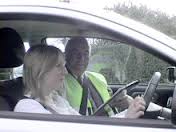The Practical driving test

The DVSA Practical driving test
Practical driving test
Before applying for a practical driving test, a candidate must have passed both components of the theory test. Passing the practical test entitles the candidate to hold a full UK driving licence. In order to pass the practical driving test, candidates will be taken on the road with an examiner. The test usually lasts 30 to 48 minutes for a standard test, or one hour for a candidate that is taking an extended test after having their licence revoked. The test is made up of four elements, excluding the “show me, tell me” all must be passed successfully.
Eyesight test
Before getting to the car, the examiner will ask the candidate to read a car’s number plate at a distance. The distance required is 20.5 meters for an old-style plate (A123 ABC) and 20 meters for a new style plate (AB51 ABC). If the candidate needs glasses to do this then these must be the ones worn whilst completing the rest of the test.
“Show me, tell me”
Before the candidate is taken out onto the road, the examiner asks two basic questions about car maintenance and safety. These are always phrased in the form “Show me…” and “Tell me…”; for example:
Show me how you would check that the power assisted steering is working before starting a journey.
Open the bonnet, identify where you would check the engine oil level and tell me how you would check that the engine has sufficient oil.
A failure to answer one or both of these questions correctly would result in a minor driving fault being marked against the candidate, making this the only section of the test where it is impossible to fail. There are 19 different questions which can be asked in 18 different combinations.
General driving
The candidate will be asked to drive a route determined by the examiner, encountering various driving environments. During the drive, the candidate will be required to drive independently for 10 minutes following signs or directions to a destination, the candidate will also be expected to pull up on the left of the road and stop before moving off again on a gradient, on the flat and behind a parked car.
Manoeuvres
During the test, the examiner will ask the candidate to carry out any one of the following manoeuvres:
Turn in the road (Used to be called three point turn)
Reverse around a corner to the left or right
Reverse Bay park (conducted in the test centre car park)
Parallel park using a parked car to reverse into the space of two car lengths
The examiner may also, optionally, ask the candidate to carry out an emergency stop exercise, usually 1 in 3 candidates are asked.
Candidates taking the test after having their licence revoked must carry out all of the manoeuvres.
The Marking and Results
During the entire driving test, the examiner will mark the candidate for driving faults, serious faults, and dangerous faults. A candidate will fail the test if he or she accumulates more than fifteen minor faults or if a “serious” or “dangerous” fault is marked. If a candidate acquires three or more driving faults within the same category, then the examiner may consider the fault to be a recurring and dangerous habit and mark a serious fault in that category.
